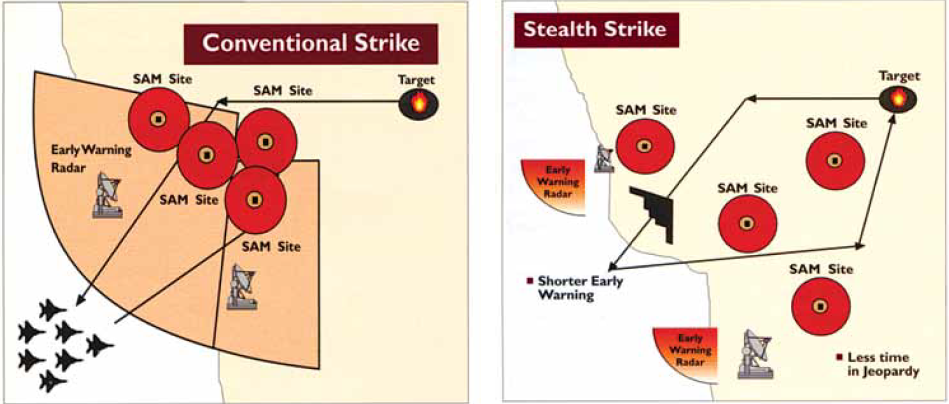All I see in this thread is trolling and an absolute lack of arguments.
----- ----- -----
B-A2 Spirit made a mockery of Yugoslavian air defenses based on Russian anti-stealth military technology and concepts.
----- ----- -----
Yugoslavia is the
only country in the world to have shot down a stealthy combat aircraft
F-117 Nighthawk in a war with NATO (
Operation Allied Force), and its military equipment and tactics are/were instructive in this regard:
Source: Clean Bombs and Dirty Wars: Air Power in Kosovo and Libya
NOTE: Soviet P-18 Spoon Rest (or
Russian 1RL131 Terek) operates in the
VHF band and its
Chinese derivative is called YLC-8A.
Yugoslavians created some of the earliest known examples of an IMAD setup involving a network of different Russian-origin radar systems including
P-18 operating across
I/D/G/H/VHF bands as a collective.
Yugoslavian air defenses were modeled to counter stealthy aircraft in view of an earlier military operation of NATO to liberate Kuwait from Iraq in 1991 (Operation Desert Storm)
but B-2A degraded them to the point of being utterly useless:
During Allied Force, the air war over Serbia, six B-2s conducted 45 sorties out of 9,211 Air Force fighter and bomber sorties in the entire war—less than a half of one percent—but they struck 33 percent of the targets in the first eight weeks of combat.
How Yugoslavian air defenses against different types of stealthy combat aircraft in real-time conditions?
Let us see.
F-117A (Sortie – Engaged – Loss) ratio in Operation Allied Force = 743 – 2 – 1
F-117A = 2nd generation stealth in American terms with limited sensor systems and without EW capabilities
B-2A (Sortie – Engaged – Loss) ratio in Operation Allied Force = 49 – 0 – 0
B-2A = 4th generation stealth in American terms with significant sensor systems and EW capabilities
Yugoslavian air defenses were able to shoot down only 2 combat aircraft of NATO in Operation Allied Force (
F-117A = 1;
F-16A Block 15 = 1).
B-2A delivered significant blows to Yugoslavian air defenses and made it much safer for the other aircraft to operate over the country by extension.
B-2A is capable of penetrating an IMAD setup while passing through:
Source: The Radar Game: Understanding Stealth and Aircraft Survivability.
Geometric shaping of
B-2A is a nearly perfect radar waves deflecting mechanism and VLO in true sense of the word because even the fuselage and tail fins are eliminated altogether.
B-2A also features substantial amount of radar waves absorbing materials within the frame. Even the engines are completely buried within the frame and exhaust systems are located on the top. Sheer size of the aircraft provided sufficient room to accommodate incredible stealthy characteristics.
B-2A ticks all the boxes of frustrating detection possibilities with a radar system (or even a network of radar systems) across a number of bands including
VHF because its returns are weak even in the Mie or Rayleigh region where resonance effects are more pronounced.
The upcoming B-21 Raider expands on this incredible design yet further, and to what extent would be an understatement.
B-2A makes it possible to attack, degrade, and destroy increasingly sophisticated defenses and infrastructure of a region in limited sorties. To bomb a country back to the stone age if necessary.
This comparison shows that just two
B-2A are sufficient to produce "battlefield effects" that would take multiple aircraft to replicate otherwise. And there is no need to use refueling tankers for
B-2A.
- Costs are reduced.
- Complexity is reduced.
- Probability of suffering losses is reduced.
----- ----- -----
F-35 variants such as
F-35A and
F-35I made a mockery of Syrian air defenses based on Russian and Chinese anti-stealth technology and concepts.
----- ----- -----
Syrian air defenses as in 2010 was based on Soviet technology including
P-18 in large part. But Assad administration
acquired Chinese Type 120, JYL-1, and YJ-27 radar systems to modernize Syrian air defenses in subsequent years. Assad administration also requested Russian assistance during the Syrian Civil War.
Russian forces created a network of an S-400 system, an
S-300 system, and
Nebo-M technology to protect Syrian airports and military bases from airborne threats.
NATO had the opportunity to probe the aforementioned Russian and Chinese military technologies in Syria while conducting a military operation against the Islamic State of Iraq and Levant (ISIL) in the region (Operation Inherent Resolve). Israel also had the opportunity to probe same technologies in Syria.
After more than two decades of development and testing, the Lockheed Martin’s F-35 Joint Strike Fighter has made its combat debut in Syria. IAF deployment of F-35 and operational engagem…

www.globaldefensecorp.com
Storehouses and radar systems said destroyed in strikes, which reportedly killed 21

www.timesofisrael.com
The Israeli Air Force’s F-35I Adir not only flew over Syria but ventured 200 kilometers inside Syria to bomb Iran-backed militants groups. Israeli named F-35I “Adir” meaning ̶…

www.globaldefensecorp.com
American F-35 fighters attacked the area of the Syrian army covered by S-400 and S-300 learned GDC quoting the USAF source. The USAF revealed on Monday, despite the fact that Russia and Syria dec…

www.globaldefensecorp.com
Israel carried out an aerial attack southeast of Syria’s northern Aleppo province late Monday, reported Reuters quoting a Syrian military official. The unidentified military official, quoted by the…

www.globaldefensecorp.com
Tensions are escalating between Iran and Israel. Israel has said it had destroyed nearly all of Iran’s military capabilities in Syria. It was reportedly retaliation for an Iranian missile att…

www.globaldefensecorp.com
First, unlike any other 4th gen. platform, the F-22 & F-35’s radar is deeply integrated with their EW suite (RWR) to the extent that they operate as a single entity and they are the most powerf…

www.globaldefensecorp.com
----- ----- -----
Russian S-400 system is one of the most advanced of its kind in the world and is equipped with several radar systems to increase its target search and detection possibilities:
https://theaviationist.com/2015/11/13/s-400-triumf-infographic/
Chinese derivative is called HQ-9 but less capable in comparison.
But F-35 variants can defeat
S-400 system and similar systems from a distance:
"Russian air defence systems are primarily unable to engage with this type of drones for several reasons, such as their small size and ability to fly slowly at low altitudes, in addition to the use of non-metallic alloys in their manufacturing, all of which makes them difficult to detect. Even if they do detect these drones, these systems are still unable to engage with targets that fly at low altitudes and speeds less than 360 km. During engagements with warplanes and missiles, it seems also that stealth and electronic jamming have been effective in making these systems blind and useless. On the other side, the S400’s radars have failed to detect the F-35 up to 34 km and the F-22 up to 21 km, whereas these aircraft can target air defence units from more than 100 km."
Russian air defence systems are primarily unable to engage with this type of drones for several reasons such as their small size

research.sharqforum.org
Two jets from different eras, with different missions, strengths, and weaknesses, face off in a battle

www.airandspaceforces.com
----- ----- -----
In view of the
FAILURE of
Soviet P-18 technology in Yugoslavia (and Syria),
Russian air defenses in Syria, and
Chinese YJ-27technology in Syria, China has come up with
YLC-8E radar system to detect stealthy combat aircraft. A notable difference is that Russian and earlier Chinese anti-stealth radar systems operate in
VHF band but
YLC-8E operates in
UHF band. However, performance of
YLC-8E is subject to speculation and exaggeration for public consumption and to create deterrence effects in typical Russian and Chinese fashion in typical Russian, Iranian, and Chinese fashion.
Americans continue to improve their operational stealthy combat aircraft and developing new types of stealthy combat aircraft.
The art shows us new features the Raptor is gaining, including stealthy fuel tanks and special underwing pods, as well as a new missile.

www.thedrive.com
A second "Chrome" F-22 has been spotted at Nellis Air Force Base operating alongside other aircraft taking part in Red Flag exercise. As we have reported

theaviationist.com
The upgrades the B-2 and its sustainment program are getting now will have a direct influence on the capabilities of the B-21 in the future.

www.thedrive.com
The F-35's Block 4 upgrade has many features, but Air Combat Command's commander says its electronic warfare abilities will be most critical.

www.thedrive.com
Keep in mind that no jet fighter is comparable to
B-2A in stealth. Jet fighters are much smaller in size and do not have sufficient space to accommodate some of the stealthy applications and design parameters found in
B-2A.
There is no proof of a reliable counter to
B-2A out there, let alone to the upcoming
B-21.
B-21 is a
BIG LEAP from
B-2A in stealth with cutting-edge technologies and innovations.
The U.S. is making a massive, strategic gamble that hasn't paid off in the past

time.com
B-21 Raider, the future of long-range strike, will be capable of penetrating the toughest defenses to deliver precision strikes anywhere in the world.

www.northropgrumman.com





















